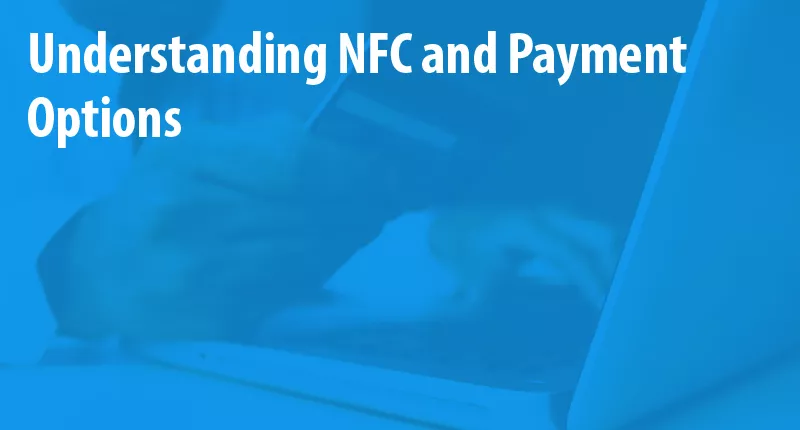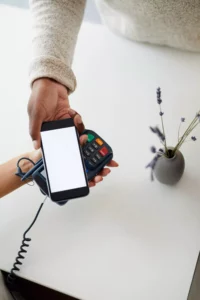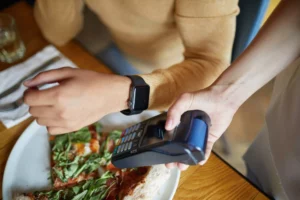
TABLE OF CONTENTS
As a business owner, understanding NFC payments and the available options can be tricky. A lot has changed in the world, particularly how your business receives and processes payments. It used to be pretty straightforward and simple, with the standard line at checkout being “cash or credit?” Now, business owners offer several different payment options, including NFC payments. NFC mobile payments offer customers a convenient and secure way to pay while speeding up transaction times and limiting physical contact. This is important as half of U.S. consumers are now using some form of contactless payment.
Thankfully, the simplicity of payment processing hasn’t gone away. NFC only enhances the payment experience and makes it safer, with a myriad of options that take technological advancements, as well as security and fraud protection strategies into account. Of all the payment options now available, the newest and perhaps most convenient is NFC.
What is NFC?
NFC stands for “near-field communication” and, as the name would suggest, it allows compatible devices that are within a short distance to communicate. In the real world, NFC is the tech that allows for safe and encrypted contactless payments from a phone or payment terminal.
Apple Pay, Google Pay, Samsung Pay, and the like are the most popular examples of NFC payment options.
How Does NFC and Payment Options Work?

Let’s tackle NFC first and then delve into some of the payment options available.
Near-field communication is deceptively simple. It evolved from radio frequency identification (RFID) tech, similar to the chip in your credit card, cell phone, and even passport. An NFC chip operates as part of a wireless link. Once it’s near another NFC chip, like one inside a payment terminal, it activates and small amounts of data can pass between the two devices.
You might be thinking this technology resembles that of Bluetooth. While Bluetooth and NFC are similar, they are not one and the same. In reality, they’re completely different technologies. As the name implies, NFC only works when two devices are close together.
There are loads of payment options out there, but the most notable NFC payment options come from familiar names. NFC mobile payments include wallet functions such as Apple Pay, Google Pay, and Samsung Pay, among others. Broadly speaking, there’s no deficit in trust with NFC technology or its payment options. The brands that have put their names behind NFC payments have built colossal equity with consumers and wouldn’t roll out or vouch for bad tech.
NFC payments work when you tap or wave your device over a terminal that’s also equipped with NFC technology. When this happens, you’re making the wireless link that securely sends and receives information. Without an NFC-enabled reader, this isn’t possible.
NFC vs. EMV: What’s the Difference?
A lot of times, people associate NFC with EMV technology and vice versa. This is because the same technological wave brought them into popularity at roughly the same time: mobile payments. Timing aside, they are very different. EMV–or Europay, Mastercard, and Visa–are credit cards with chips in them. This technology replaced magnetic stripes as a faster, safer, and more secure alternative.
For one reason or another, the United States has been extremely late to adopt this technology. Because of this, we’ve been playing catch-up with the rest of the world. At this point, it’s very likely that you’ve come in contact with NFC or another form of contactless payment. Many banks are mailing replacement cards for non-chip versions. Additionally, any new cards issued will come with NFC technology by default.
Naturally, payments made via EMV cards are processed differently than swiped cards. Swiping as it relates to a magnetic stripe has become dipping the card into an EMV-enabled reader. If you’re running a business, it’s imperative to get a point-of-sale terminal that’s capable of taking EMV cards, if not NFC payment options as well. Doing so will help you let your customers pay their favorite way. This in turn will drive customer satisfaction and could even build trust and loyalty.
Are NFC and Payment Options Safe?
While this may seem like a no-brainer, it’s very valid and important to understand in detail, especially since the communication is happening wirelessly. It feels like there’s a lot of room for danger and fraudulent behavior. Despite this, NFC and payment options affiliated with the technology are actually safer for consumers than their technological predecessors. The reason why is because of something called “tokenization.”
Tokenization is yet another layer of protection that comes with NFC and payment options that utilizes the technology. Tokenization is the process of randomly generating numbers, or tokens, and associating them with credit card numbers. Tokens link your card to the virtual card on your device. In a nutshell, this means your sensitive data stays with you throughout the payment process and only your bank has access to it.

As far as encryption goes, NFC and payments are not only encrypted but they’re dynamically encrypted. This means that each transaction uses a unique code. Taken together, tokenization and encryption create a payment ecosystem that’s extremely safe and secure. More than that, the physical distance NFC payments need to initiate a transaction–those few centimeters–doesn’t leave a lot of space for crooks to steal your data.
Regarding EMV chip cards, the move away from magnetic stripes of yesteryear has been huge for fraud prevention. Visa even went so far as to report it’s reduced counterfeit fraud by three quarters.
Using NFC for Payments
All of this plays into why your business should be migrating towards and using NFC mobile payments. The built-in security provides unparalleled peace of mind for customers and business owners.
While EMV is great, and many POS and mobile/wireless terminals handle that as well as NFC, letting customers use NFC to pay has yet another advantage: speed.
Initiating a transaction takes time. You play the waiting game until you hear the terminal buzz or the cashier has to remind you to remove your card. There’s a lot of processing going on and that’s fine and very necessary. NFC, on the other hand, is comparatively instantaneous, just a hover over or a tap on the terminal.
As our phones become more and more capable of handling our day-to-day personal business, NFC mobile payments become more and more attractive. The fact of the matter is, you may forget your wallet, but you’re not forgetting your phone.
Conclusion
At the end of the day, businesses will inevitably move towards what is most safe, convenient, and secure for customers and business owners alike. Using NFC to pay does that better than any other option in the payments space and all it takes to adapt to the newest technology is upgrading to NFC-enabled readers. Consider the value add this switch could make for your business.





